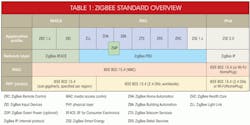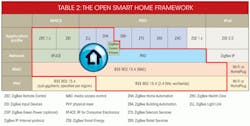OSF Will Speed Up ZigBee’s Adoption In The Smart Home
The Open Smart Home Framework (OSF) comprises the components of the ZigBee (IEEE 802.15.4) standard family that are relevant for the home and the consumer. It combines these components into an architecture that allows for an easy to install, maintenance-free, reliable, secure, and cost-effective sense and control network implementation, while making the different ZigBee network layers or other underlying technologies invisible to the user.
OSF’s goal is to make ZigBee as successful, ubiquitous, and easy to use as Wi-Fi is today. It was created to enable product builders to design and develop a plethora of new devices and applications for the smart home, as well as to develop a cost-effective means for them to connect their existing in-home devices to the Web.
Where Is ZigBee Today?
ZigBee is a group of standards owned by the ZigBee Alliance, an organization with more than 400 (paying) members (Table 1). It serves the standardization of sense and control networks in a wide variety of application domains such as home/consumer, smart energy/grid, building automation, and retail automation. All of these standards use the same underlying radio technology and comply with worldwide radio certification rules. A ZigBee radio certified for use in the United States is also certified for use in Europe, China, and the rest of the world.
There are many similarities between the ZigBee Alliance (addressing sense and control networks) and the WiFi Alliance (addressing high-speed content sharing and distribution networks). Both standards follow the International Standards Organization (ISO) layered model and are based on open IEEE standards (defining the bottom two layers of the model). Also, both offer similar ranges and the ability to transmit through furniture, walls, and floors. Both use the worldwide available 2.4-GHz spectrum as well. The main difference is that Wi-Fi is building on the Internet Engineering Task Force (IETF) for the network layers (TCP/IPv4/v6), where the ZigBee Alliance has taken the responsibility for standardization of the upper layers, up to the application level.
Related Articles
• Wi-Fi/ZigBee Chip Eases IoT Implementation
• Decade of ZigBee Wireless
• Hybrid HAN SoCs Integrate ZigBee And HomePlug Green PHY
The ZigBee media access controller (MAC) layers and physical layers (PHYs) have been defined as part of the IEEE 802.15.4 work. The three network layers in ZigBee are RF4CE, PRO, and Green Power, where Green Power essentially is a feature of PRO. A fourth network layer, ZigBee IP (ZIP), is under development. These three existing layers are quite complementary.
RF4CE is intended for devices that require a lot of human interface like keyboards or remote controls where low latency and low power are key characteristics. It also offers star-networking capabilities (point-to-multipoint).
PRO can be considered “the backbone” network layer of ZigBee, where the key characteristic is mesh networking with the ability to cover large areas with redundant connections, providing reliable coverage. Green Power is a feature of PRO and supports ultra-low-power devices that are powered by energy harvesters or (non-replaceable) batteries. These Green Power devices are part of the network, but usually, they’re only included in network activity when they have to be. Otherwise, they’re completely shut down.
Also, ZigBee PRO is defined as a backbone network for the sensors and actuators in the home. These sensors are often battery powered, while the actuators (HVAC systems, security alarms, kitchen appliances) tend to be mains powered. RF4CE handles the (mostly battery powered) human input devices and controllers. Green Power does the job for the simplest devices, even allowing them to work without batteries, operating from the power generated by energy harvesters.
OSF’s Role
OSF has been specifically defined for ZigBee-based home management (sense and control) networks, with the goal of making ZigBee as easy to use as Wi-Fi is today (Table 2). Sense and control networks don’t focus on high data rate (compared to Wi-Fi), but on availability: easy to install, maintenance-free, reliable, secure, and cost effective.
A subset of the ZigBee standards, OSF specifically addresses those elements that are playing a role for the consumer in the home. Therefore, OSF is not a standard in itself, but a framework that specifically addresses the needs and the coexistence of the different ZigBee standards within the home/consumer space.
OSF covers the communication between all the devices in the home that are not naturally related to content sharing or distribution. Wireless content sharing (Internet, pictures, music, video, TV, VoIP, etc.) is the domain of Wi-Fi, where data rate requirements dominate all other requirements. OSF is for connecting all the other devices in the home that do not require high data rates.
For example, low-data-rate devices and gadgets include everything from dishwasher controls to light switches, from motion sensors to door bells and from lights to thermostats. It is quite obvious that the dynamic range covered by these devices is of a different order compared to the devices covered by Wi-Fi. With ZigBee, we are usually talking about a limited number of bits to be transmitted at data rates of 250 kbits per second, which is slow compared to Wi-Fi’s data throughput of up to 600 Mbits/s, but very energy efficient!
With OSF, all of these ZigBee connected gadgets and devices are brought together under one umbrella from which they can be reached from anywhere in the home, as well as from any place in the world.
The end user does not need to recognize or understand the various flavors of ZigBee (PRO, RF4CE, or Green Power). Just like Wi-Fi, they only need to understand that ZigBee is the radio technology that connects all the devices in the home and enables them to control it all from a smart phone anywhere in the world. Once they have a ZigBee-based network in their home, all they need to do to add new devices and services is to power on the new ZigBee sensors and devices and they will automatically connect to the network, ready to do their job.
Cees Links is the founder and CEO of GreenPeak. Under his responsibility, the first wireless LANs were developed, ultimately becoming household technology integrated into PCs and notebooks. He also pioneered the development of access points, home networking routers, and hotspot basestations. He was involved in the establishment of the IEEE 802.11 standardization committee and the Wi-Fi Alliance. And, he was instrumental in establishing the IEEE 802.15 standardization committee to become the basis for the ZigBee sense and control networking.
About the Author
Cees Links
General Manager, Wireless Connectivity Business Unit
Cees Links is a Wi-Fi pioneer. Under his responsibility, the first wireless LANs were developed, ultimately becoming household technology integrated into PCs and notebooks. He also pioneered the development of access points, home networking routers, and hotspot base stations. He was involved in the establishment of the IEEE 802.11 standardization committee and the Wi-Fi Alliance. He was also instrumental in establishing the IEEE 802.15 standardization committee to become the basis for the Zigbee sense and control networking.
Cees was the founder and CEO of GreenPeak Technologies, now part of Qorvo, and is now the General Manager of the Wireless Connectivity Business Unit. He was recognized as Wi-Fi pioneer with the Golden Mousetrap Lifetime Achievement award.


